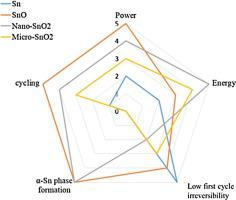当前位置:
X-MOL 学术
›
Synth. Met.
›
论文详情
Our official English website, www.x-mol.net, welcomes your
feedback! (Note: you will need to create a separate account there.)
Influence upon cycling of oxygen amount in tin-based compound used as negative electrode in lithium-ion battery
Synthetic Metals ( IF 4.0 ) Pub Date : 2020-09-01 , DOI: 10.1016/j.synthmet.2020.116477 Charlotte Gervillié , Aurélie Boisard , Julien Labbé , Sandrine Berthon-Fabry , Katia Guérin
Synthetic Metals ( IF 4.0 ) Pub Date : 2020-09-01 , DOI: 10.1016/j.synthmet.2020.116477 Charlotte Gervillié , Aurélie Boisard , Julien Labbé , Sandrine Berthon-Fabry , Katia Guérin

|
Abstract Electrochemical and physicochemical characteristics of three tin-based materials with various oxygen amount used as negative electrode in lithium-ion battery have been evaluated and compared. Nanosizing structuration impact in case of SnO2 is also discussed. Depending on the oxygen amount in those materials used as electrode, energy and power density of lithium-ion battery can be modulated up to 2000 Wh/kg and 8000 W/kg for a maximum sustainable 3C rate. Fading depends mainly on the oxygen amount and, to a lesser extent, on nanostructuration. SnO appears as the best candidate in this material family concerning irreversible capacities and coulombic efficiency. Post-mortem characterizations after 100 cycles by XRD, SEM and EDX highlight a lower aggregation of tin particles for oxygen-based materials upon cycles and formation of α- crystallographic tin phase which can be supposed as beneficial for coulombic efficiency.
中文翻译:

锂离子电池负极锡基化合物氧量对循环的影响
摘要 评价和比较了三种不同含氧量的锡基材料作为锂离子电池负极的电化学和理化特性。还讨论了 SnO2 的纳米尺寸结构影响。根据用作电极的材料中的氧含量,锂离子电池的能量和功率密度可以调节至 2000 Wh/kg 和 8000 W/kg,以实现最大的可持续 3C 率。褪色主要取决于氧量,在较小程度上取决于纳米结构。在不可逆容量和库仑效率方面,SnO 似乎是该材料系列中的最佳候选材料。通过 XRD 进行 100 次循环后的验尸表征,
更新日期:2020-09-01
中文翻译:

锂离子电池负极锡基化合物氧量对循环的影响
摘要 评价和比较了三种不同含氧量的锡基材料作为锂离子电池负极的电化学和理化特性。还讨论了 SnO2 的纳米尺寸结构影响。根据用作电极的材料中的氧含量,锂离子电池的能量和功率密度可以调节至 2000 Wh/kg 和 8000 W/kg,以实现最大的可持续 3C 率。褪色主要取决于氧量,在较小程度上取决于纳米结构。在不可逆容量和库仑效率方面,SnO 似乎是该材料系列中的最佳候选材料。通过 XRD 进行 100 次循环后的验尸表征,











































 京公网安备 11010802027423号
京公网安备 11010802027423号